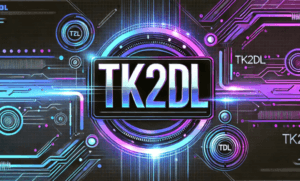What is tk2dl?
tk2dl is a sophisticated data management platform designed to streamline and enhance data processing capabilities for enterprises and individual users alike. It integrates various functionalities that allow users to access, manipulate, and analyze data efficiently. Originating from a need to manage increasing volumes of information in today’s digital age, tk2dl was developed to meet the demands of modern data-centric environments. The platform is based on fundamental principles of accessibility, scalability, and security, making it an essential tool for organizations looking to leverage their data effectively.
In the context of contemporary technology, tk2dl serves as a pivotal element within data analysis frameworks. Its relevance is amplified by the growing reliance on data-driven decision-making across industries, such as finance, healthcare, and education. By providing a user-friendly interface coupled with robust analytical tools, tk2dl empowers users to extract meaningful insights from complex datasets. Unlike other data management solutions, tk2dl specializes in high-speed data retrieval and manipulation, often resulting in quicker project turnaround times.
Examples of tk2dl applications can be observed across various sectors. In finance, for example, tk2dl assists in real-time data analytics to improve investment strategies and risk assessments. In the healthcare sector, it enables practitioners to analyze patient data swiftly, leading to enhanced patient outcomes. Additionally, in the educational realm, tk2dl supports data management systems that track student performance metrics, facilitating targeted interventions. These diverse applications underscore the versatility of tk2dl, showcasing its potential to drive innovation and efficiency in different environments.
Key Features and Advantages of tk2dl
tk2dl offers a range of features that make it an exceptional tool for users seeking to optimize their workflows. One of the primary advantages is its ease of use. The platform is designed with user experience in mind, allowing both novice and experienced users to navigate seamlessly through its interface. This user-centric approach reduces the learning curve, enabling users to quickly adapt and utilize tk2dl to their advantage.
Another significant benefit is the efficiency of tk2dl. By automating routine tasks, it allows users to focus on more strategic work rather than mundane processes. For instance, a marketing team utilizing tk2dl can automate their reporting procedures, which not only saves time but also enhances data accuracy. This improved efficiency translates directly into increased productivity for businesses, allowing teams to allocate resources where they are needed most.
Scalability is also a notable feature of tk2dl. As organizations grow, their needs often change, and tk2dl adapts fluidly to accommodate these shifts. Whether it’s managing a small project or a large-scale operation, the platform scales effectively without compromising performance. Companies that have transitioned to tk2dl have reported significant improvements in their project management capabilities as a result.
Furthermore, tk2dl excels in integration capabilities. It seamlessly integrates with various applications, which means users can connect their existing tools and workflows without any disruptions. This flexibility is crucial for teams that rely on different software solutions to accomplish their tasks. By leveraging tk2dl’s integration features, users can create a cohesive ecosystem that supports their business objectives.
Real-world testimonials highlight these advantages. One satisfied user remarked that tk2dl transformed their project completion rates, allowing them to meet deadlines consistently. Such endorsements reinforce the premise that tk2dl not only optimizes workflows but also drives substantial productivity gains for its users.

Getting Started with tk2dl
Embarking on your tk2dl journey requires a few essential steps to ensure a smooth experience. Firstly, confirm that your system meets the prerequisites for tk2dl installation. This typically includes a compatible operating system and sufficient memory resources. Identifying these requirements early on will help avoid potential issues during installation.
To begin, download the latest version of tk2dl from the official website or a reputable source. During this process, verify the integrity of the downloaded file, as this ensures that your installation will be free from corruption. Next, follow the installation instructions carefully, as they may vary based on your operating system. Generally, the installation will involve running a setup executable or utilizing package management systems for Unix-based environments.
Once installed, the initial setup of tk2dl is crucial. Here, you will need to configure some basic parameters to tailor the software to your preferences. This may include setting user preferences, choosing default directories for file storage, and integrating necessary plugins or extensions that enhance tk2dl’s functionality. Taking the time to familiarize yourself with these settings will optimize your experience in the long run.
For first-time users, it is beneficial to explore additional resources to aid your understanding of tk2dl. Numerous tutorials, user forums, and online communities are available where beginners can ask questions, share experiences, and gather insights on effective usage. Engaging with these platforms will not only provide helpful guidance but also connect you with experienced users who can offer tips and tricks.
By following these steps for installation and setup, newcomers to tk2dl can equip themselves with the necessary foundation to explore the various capabilities of the framework efficiently.
Future of tk2dl: Trends and Predictions
The future of tk2dl appears to be promising, shaped by a myriad of emerging technologies and evolving user needs. One significant trend is the integration of artificial intelligence and machine learning into tk2dl functionalities. Experts predict that these technologies will enhance data processing capabilities, enabling more efficient and tailored solutions for users. As machine learning algorithms become more sophisticated, tk2dl is expected to leverage them for predictive analytics, allowing users to make well-informed decisions based on real-time insights.
Moreover, the Internet of Things (IoT) is poised to play a crucial role in the expansion of tk2dl. The growing number of connected devices can provide valuable data that tk2dl can analyze and interpret, leading to enhanced user experience through personalized interfaces. This convergence of tk2dl with IoT not only broadens the scope of its application but also creates opportunities for integration with smart home systems, wearable technology, and industrial automation. Such integrative measures can streamline workflows and provide end-users with comprehensive solutions tailored to their specific environments.
Furthermore, the growth of user communities and platforms dedicated to feedback will significantly influence the trajectory of tk2dl. Engaging with users allows for a more governed evolution of the platform as it adapts to real-world applications and user experiences. The feedback loop created through community engagement will foster innovation, leading to the introduction of new features and refining existing ones. As user demands evolve, tk2dl must remain agile, adapting to these changes while continuing to provide robust solutions.
In summary, as tk2dl navigates its future, advancements in technology coupled with active user engagement will undoubtedly shape its course. By embracing these trends, tk2dl stands to revolutionize its offerings, ensuring it remains relevant in an ever-evolving digital landscape.

















